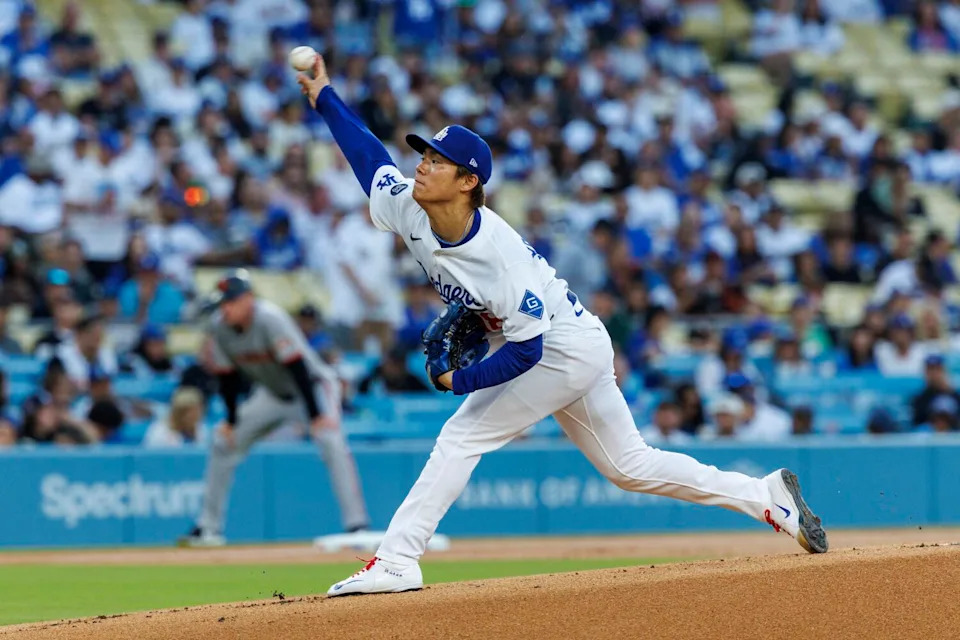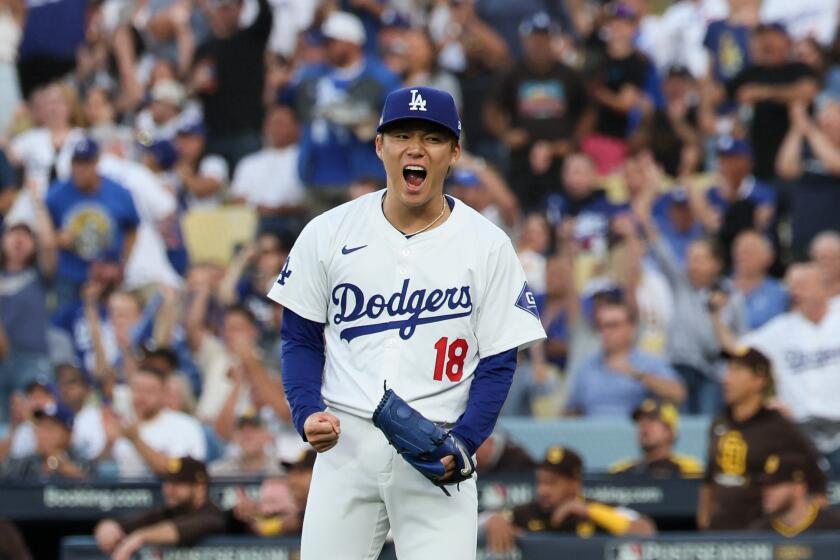Blue towels swirled around in every section of Dodger Stadium as his entrance song started to play.
Yoshinobu Yamamoto stepped on the mound and into the chaos wearing a mask of calm. His appearance was misleading.
Advertisement
Inside, he was terrified.
“I think that was the game for which I was the most nervous in my entire baseball career,” Yamamoto said in Japanese.
Yamamoto can laugh now about his memories of Game 5 of the National League Division Series against the San Diego Padres last season, knowing what was revealed on that October night and the path on which it set him.
Read more: Shaikin: How to revitalize baseball’s All-Star Game? Bat flips
He started that game as an unknown, even to himself. He departed a hero. By the end of the month, he was a World Series champion.
The momentum he gained in the playoffs carried into this season, which explains why the 26-year-old right-hander was at the All-Star Game in Atlanta earlier this week reliving what might have been the most consequential start of his career.
Advertisement
The Dodgers will return from the All-Star break on Friday with Yamamoto as the only dependable arm in their billion-dollar rotation, and his newfound status as one of the best pitchers in baseball makes him their likely Game 1 starter when they open the postseason.
“He’s just to the point where he knows he’s a really good pitcher, he’s an All-Star and he has high expectations for himself,” manager Dave Roberts said.
The sense of stability that Yamamoto provides was something the Dodgers couldn’t have dreamed of in his up-and-down rookie season last year. Yamamoto encountered difficulties that were unknown to him as a three-time Pacific League most valuable player with Japan’s Orix Buffaloes, missing three months with shoulder problems. Even when he pitched, he performed inconsistently, and in Game 1 of the NLDS against the Padres, he gave up five runs in only three innings.
“The more I failed, the more it felt like things were piling up,” Yamamoto said.
Advertisement
With a two-games-to-one deficit in the series, the Dodgers managed to win Game 4 in San Diego to set up a winner-take-all Game 5 in Los Angeles. Yamamoto was assigned to start the deciding game.
Yamamoto had difficulty sleeping the night before his start. When he tried to think of anything other than the game, he couldn’t.
Dodgers pitcher Yoshinobu Yamamoto delivers against the Chicago White Sox on July 1. (Gina Ferazzi / Los Angeles Times)
He felt the weight of his 10-year, $325-million contract, which was the most lucrative deal signed by any pitcher from any country. He was also pitching opposite Yu Darvish, making this the first postseason game featuring two Japanese starting pitchers.
His worst fears were never realized. He pitched five scoreless innings in a 2-0 victory, delivering a performance that changed how everyone viewed him — the fans, the team, even himself.
Advertisement
“Being able to contain them there,” Yamamoto said, “became a source of confidence.”
Yamamoto downplayed his psychological fortitude that was required to regroup in the wake of his Game 1 calamity, describing his turnaround as a function of his ability to identify problems and remedy them.
“I’m by no means strong mentally,” he said. “When I get hit, there are times I get really down. But as time passes, things clear up. What I have to do becomes clear.”
Between the two NLDS starts, for example, Yamamoto adjusted the positioning of his glove, which the Dodgers believed revealed in Game 1 which pitches he was about to throw.
Advertisement
His celebration, however, was short-lived.
“I felt like I cleared a mountain,” Yamamoto said. “But there was no time to relax before the next game started.”
Yamamoto started twice more in the playoffs, in Game 4 of the NL Championship Series against the New York Mets and Game 2 of the World Series against the New York Yankees. He gave up a combined three runs in a combined 10 ⅔ innings over the two games, both of which the Dodgers won.
“I think it was a really valuable experience,” he said. “Because of what I experienced, along with the advances I made from a technical standpoint, I think I was able to grow.”
Advertisement
Read more: ‘Put a ‘W’ next to Dino’s name.’ NL wins All-Star Game swing-off, with help from Dino Ebel
He also drew from the unpleasant times, particularly the three months he was sidelined with a strained rotator cuff.
“I spent the time determined to grow from that,” he said. “I don’t want to forget how frustrated I was.”
The experiences gave him a baseline of knowledge he could take into his second season. As a rookie, he had reported to camp without any expectations.
“I didn’t know what my ability was relative to everyone else’s,” he said. “I lacked a basic understanding of, ‘If I do this, it will work, or if I do that, it won’t.’ So I wasn’t thinking I’d be successful and I wasn’t thinking I wouldn’t be either. I really didn’t know.”
Advertisement
This spring training, he knew. He knew he could succeed.
He also knew what he was up against. Standing a modest 5-foot-10, Yamamoto was struck as a rookie by the imposing physical frames of the other players.
“More than that, when you get to the ballpark, for example, Mookie [Betts] will be finishing up hitting drenched in sweat ,” he said. “ I was surprised by the amount of training, that players weren’t just relying on their talent. It was a little shocking.”
Recognizing that he lost weight over the course of last season, Yamamoto was determined to report to spring training this year with a stronger body. He also benefited from increased comfort with low-quality American baseballs and the pitch clock. He purchased a home, the off-field stability permitting him to focus more on his work.
Advertisement
Pitching once a week as he did in Japan, Yamamoto was 4-2 with a 0.90 earned-run average in his first seven starts of this season. He started pitching on five-days’ rest after that, and he wasn’t nearly as dominant. He initially struggled pitching on a shorter cycle, but he said the causes of that were disruptions to his between-starts routine rather than anything fatigue-related.

Dodgers pitcher Yoshinobu Yamamoto delivers against the San Francisco Giants on June 13. (Robert Gauthier / Los Angeles Times)
“I think there is absolutely no problem with that,” he said. “You pitch on six days’ rest in Japan, but you throw 120, 130 pitches in seven or eight innings. That was tough. You have one less day to recover here, but you’re also throwing fewer pitches, so you don’t feel the fatigue that much.
“There are things that come up in between starts. For example, there could be two flights or you could arrive in a city in the middle of the night and have to pitch the next day. You won’t be able to spend every five-day period the same way.”
Advertisement
Yamamoto said he learned to better maximize his time between starts, which he pointed to as the reason he was able to regain his form leading up to the All-Star break. In his penultimate appearance before the intermission, he didn’t make it out of the first inning and was charged with five runs, three of them earned. But in two of his last four starts, he didn’t give up any runs. In another, he yielded just one.
In fact, Yamamoto said that if the team asks, he thinks he could pitch on four days’ rest.
“This year, my body has recovered really well,” he said. “I often check with the trainers after the game, and we talk about how if it’s like this, I could throw in four days, or how if I feel like that, I might be a little later. We go through different scenarios like that every week. I still haven’t started on four days’ rest, but I think my preparation to do that has gone well.”
Yamamoto enters the final 2 ½ months of the regular season not only as the Dodgers’ leader in wins (eight) but also games started (19) and innings pitched (104 ⅓).
Advertisement
His increased comfort has extended into the clubhouse. He forged a somewhat unlikely friendship with South Korean Hyeseong Kim, the two of them often conversing on the bench during games.
Read more: ‘It was awesome.’ Clayton Kershaw is the All-Star among All-Stars as NL defeats AL
“We speak to each other in broken English,” Yamamoto said with a chuckle. “I really like Korean food, so he teaches me about that. There are differences between Korean and Japanese baseball, and the major leagues are a little different too, so stuff like that. They aren’t deep conversations, but I think it’s important to communicate, so we talk a lot.”
Yamamoto has also developed a particularly strong admiration of Clayton Kershaw.
Advertisement
“In him, you have a player on the team whom you can model yourself after,” Yamamoto said. “I also learn a lot watching him pitch. He’s someone you can admire in every aspect. All of my teammates think of him like that too. That’s the kind of player I would like to be.”
The kind of player who could be counted on to take his turn in the rotation. The kind of player who can deliver for his team in big moments.
Yamamoto is on his way.
Sign up for more Dodgers news with Dodgers Dugout. Delivered at the start of each series.
This story originally appeared in Los Angeles Times.
Read the full article here


